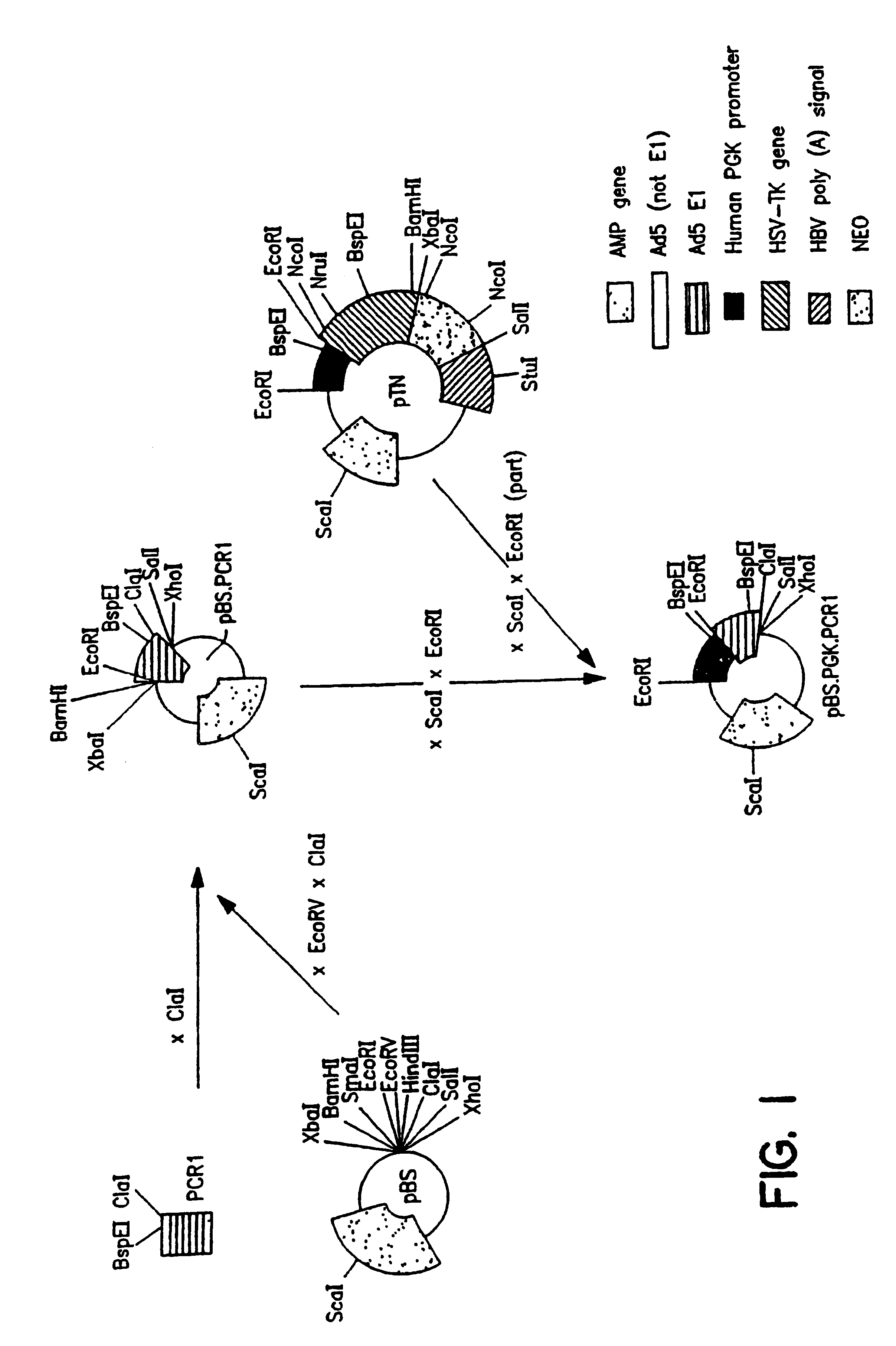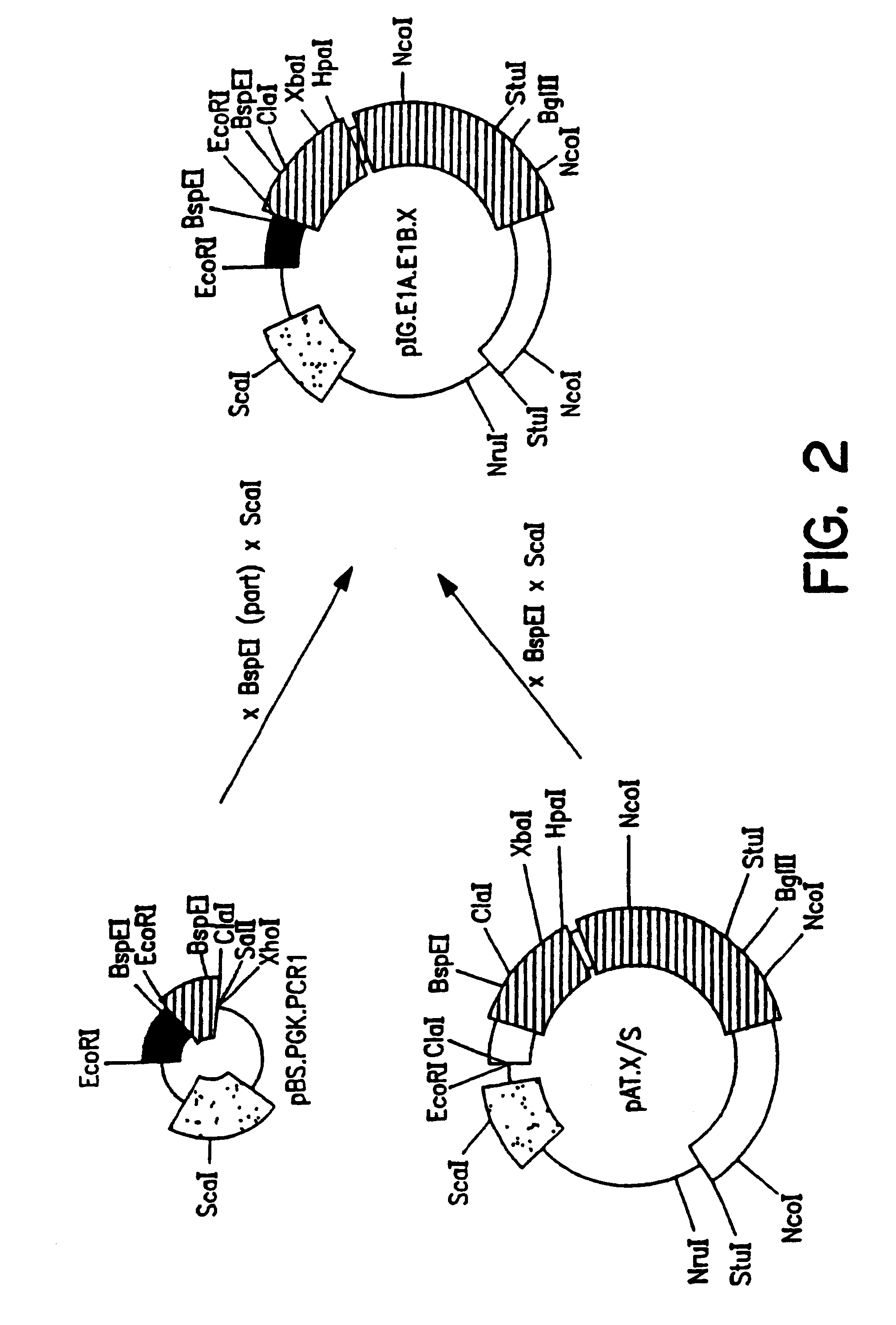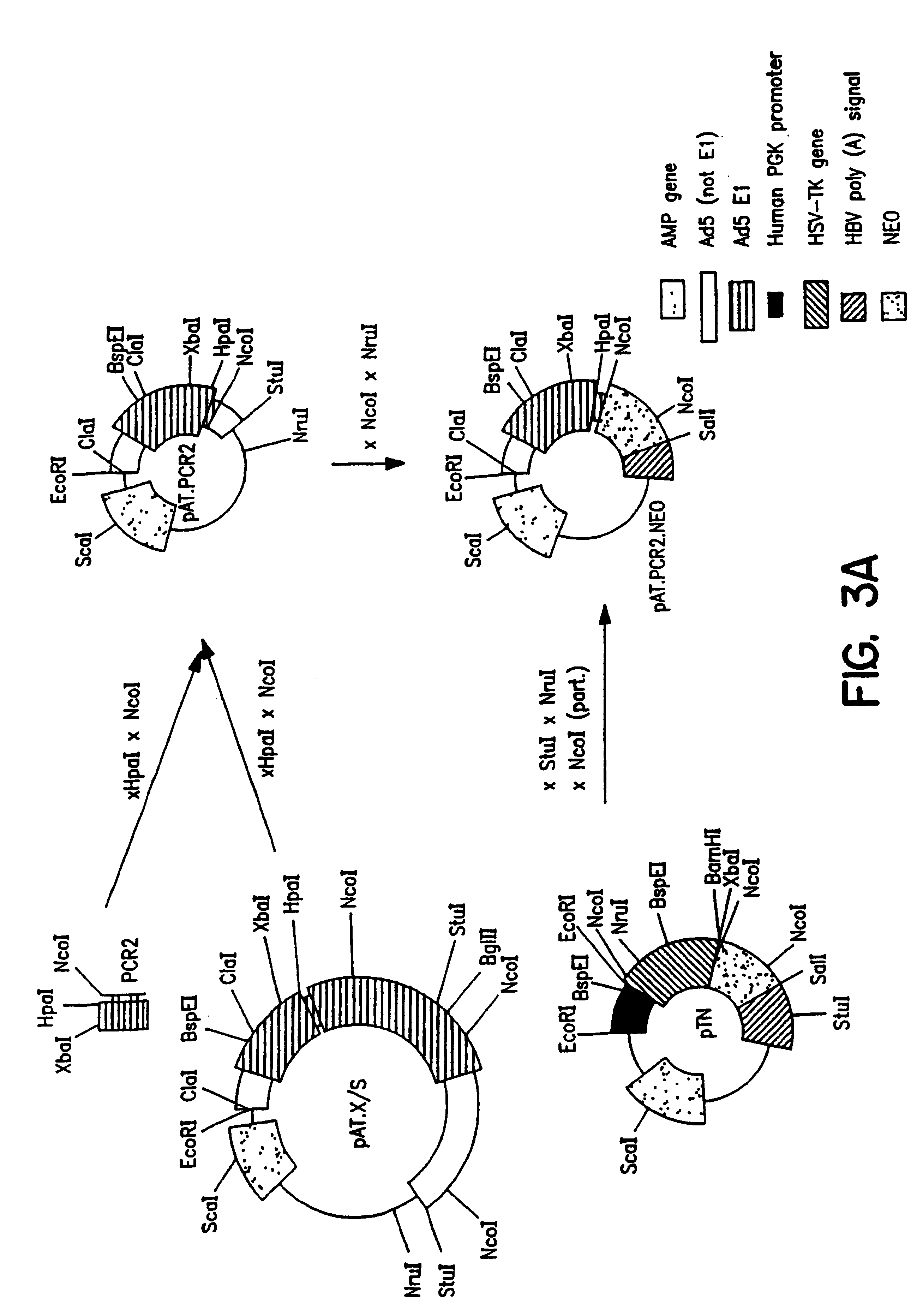However, the expression of E1A, in most cases, results in the induction of
programmed cell death (
apoptosis), and only occasionally immortalization is obtained (see Jochemsen, et al., EMBO J.
However, a problem associated with current recombinant adenovirus technology is the possibility of unwanted generation of replication competent adenovirus ("RCA") during the production of recombinant adenovirus (see Lochmuller et al., "Emergence of Early Region 1-Containing Replication-Competent Adenovirus in Stocks of Replication-Defective Adenovirus Recombinants (.
DELTA.E1+.
DELTA.E3) During Multiple Passages in 293 Cells", Human
Gene Therapy 5, pp.
RCA in batches to be used in clinical trials is undesirable because 1) RCA will replicate in an uncontrolled fashion, 2) RCA can complement replication defective recombinant adenovirus, causing uncontrolled multiplication of the recombinant adenovirus, and 3) batches containing RCA induce significant
tissue damage and hence strong
pathological side effects (see the Lochmuller article).
However, the strategies which circumvent the immune response have their limitations.
For example, the use of ts
mutant recombinant adenovirus diminishes the immune response to some extent, but was less effective in preventing
pathological responses in the lungs (see Engelhardt et al., "Prolonged
Transgene Expression in Cotton Rat
Lung with
Recombinant Adenoviruses Defective in E2A", Human
Gene Therapy 5, pp.
However, a major drawback of this
system is the fact that, although the E2A
protein is unstable at the non-permissive temperature, the immunogenic
protein is still being synthesized.
An additional difficulty associated with the use of ts125
mutant adenoviruses is that a
high frequency of reversion is observed.
Although encouraging results have been obtained with rAV, two major problems are associated with the use of rAVs.
The appearance of RCA in rAV batches is a chance event and is therefore unpredictable and difficult to control.
This is a significant problem for good manufacturing practices, particularly if large scale batches have to be prepared.
In addition, inadvertent cross-
contamination can occur in laboratories where replication-competent adenoviruses are propagated.
The presence of RCA in rAV-batches to be used in human patients is clearly undesirable, as the RCA may replicate in an uncontrolled manner in the patient.
Although the replication of the RCA is limited by the recipient's
immune system, it is a potential
hazard, especially in immuno-compromised patients.
Such inflammatory responses may be caused by the fact that multiplication of the adenovirus causes
tissue damage, or by the fact that large amounts of adenovirus proteins are synthesized that are toxic for cells (e.g., hexon and penton), and are very immunogenic.
Thus, the presence of RCA in rAV batches to be used in, for example, clinical trials is undesirable, as it may induce significant
pathological side effects.
Therefore, labor-intensive and expensive RCA screening tests such as the
tissue culture method, the supernatant rescue
assay, and
PCR assay are required (see Dion et al., "Supernatant Rescue
Assay Versus
Polymerase Chain Reaction for Detection of Wild-Type Adenovirus-Contaminating Recombinant Adenovirus Stocks", J. Virol. Methods 56(1), pp.
Screening for RCA has significantly increased the manufacturing costs of clinical rAV lots, and has led to delays in onsets of clinical studies.
Thus, the presence of RCA in preparations of adenoviral vectors with altered
tropism constitutes a potential
safety risk.
Also, in infants with an intact
immune system, adenovirus infections can cause severe
health problems and even death (see Munoz et al., "Disseminated Adenovirus
Disease in Immunocompromised and Immunocompetent Children", Clin. Infect. Dis. 27(5), pp.
Considering the magnitude of the problem, considerable research and effort has been devoted to solving the RCA problem.
However, a potential problem associated with the use of 293-based
cell lines is that
homologous recombination in the E1 region of adenovirus will generate adenoviruses which have reacquired the E1 region, but still have defects in their E2 or E4 genes.
Such an adenovirus revertant is not an RCA in the strict sense, as it is not able to replicate independently in human cells.
However, the presence of the E1 region in such E1 revertants (designated "REA": revertant E1 adenoviruses) poses another risk; that being the Ad E1 region having the potential to transform and immortalize
rodent cells, and, albeit with much lower frequency, some
human cell types.
On the one hand, given the fact that the E1A and E1B proteins contain strong CTL epitopes, the risk may be only theoretical for immunocompetent individuals.
On the other hand, REAs may be harmful for immunocompromised patients.
Major hurdles in this approach are a) that E2A should be expressed to very high levels and b) that E2A
protein is very toxic to cells.
When reversion occurs in a
cell line harboring ts125 E2A, this will be lethal to the cell.
These cells can not be used directly for the production of recombinant human adenovirus, as human adenovirus cannot replicate or only replicate to low levels in cells of monkey origin.
Furthermore, the present invention includes:
1. Packaging constructs that are mutated or deleted for E1B 21 kD, but just express the 55 kD protein.
2. Packaging constructs to be used for generation of complementing packaging cell lines from
diploid cells (not exclusively of human origin) without the need of selection with marker genes. These cells are immortalized by expression of E1A. However, in this particular case, expression of E1B is essential to prevent
apoptosis induced by E1A proteins. Selection of E1 expressing cells is achieved by selection for focus formation (immortalization), as described for 293 cells (see the Graham article) and 911 cells (see the Fallaux 1996 article), that are E1-transformed human embryonic
kidney (HEK) cells and human embryonic retinoblasts (HER), respectively.
3. After
transfection of HER cells with construct pIG.E1B (FIG. 4), seven independent cell lines could be established. These cell lines were designated PER.C1, PER.C3, PER.C4, PER.C5, PER.C6.TM., PER.C8 and PER.C9. PER denotes PGK-E1-Retinoblasts. These cell lines express E1A and E1B proteins, are stable (e.g., PER.C6.TM. for more than 57 passages) and complement E1 defective adenovirus vectors. Yields of recombinant adenovirus obtained on PER cells are a little higher than obtained on 293 cells. One of these cell lines (PER.C6.TM.) has been deposited at the ECACC under number 96022940.
4. New adenovirus vectors with extended E1 deletions (deletion nt. Those viral vectors lack sequences homologous to E1 sequences in said packaging cell lines. These adenoviral vectors contain pIX
promoter sequences and the pIX gene, as pIX (from its natural
promoter sequences) can only be expressed from the vector and not by packaging cells (see Matsui et al., Adenovirus 2
Peptide IX is Expressed Only on Replicated
DNA Molecules", Mol. 4149-4154 (1986), hereby incorporated herein by reference, and the Imler article).
5. E2A expressing packaging cell lines preferably based on either E1A expressing established cell lines or E1A-E1B expressing
diploid cells. E2A expression is either under the control of an inducible
promoter or the E2A ts125
mutant is driven by either an inducible or a constitutive promoter.
6. Recombinant adenovirus vectors as described before (see 4 above) but carrying an additional deletion of E2A sequences.
7. Adenovirus packaging cells from monkey origin that are able to trans-complement E1-defective
recombinant adenoviruses. They are preferably co-transfected with pIG.E1AE1B and pIG.NEO, and selected for NEO resistance. Such cells expressing E1A and E1B are able to transcomplement E1 defective recombinant
human adenoviruses, but will do so inefficiently because of a block of the synthesis of late adenovirus proteins in cells of monkey origin (Klessig and Grodzicker, 1979). To overcome this problem, the present invention relates to generating recombinant adenoviruses that harbor a host-range
mutation in the E2A gene, allowing
human adenoviruses to replicate in monkey cells. Such viruses are generated as described in FIG. 12, except
DNA from a hr-mutant is used for
homologous recombination.
8. Adenovirus packaging cells from monkey origin as described under 7, except, that they will also be co-transfected with E2A sequences harboring the hr
mutation. This allows replication of
human adenoviruses lacking E1 and E2A (see under 6). E2A in these cell lines is either under the control of an inducible promoter or the tsE2A mutant is used. In the latter case, the E2A gene will thus carry both the ts
mutation and the hr mutation (derived from ts400). Replication competent human adenoviruses have been described that harbor both mutations (see the Brough article and the Rice and Klessig article).
The major problems associated with the current adenovirus-derived vectors are:
As a result of the development of neutralizing antibodies, a subsequent administration of the
virus will be less effective or even completely ineffective.
However, a prolonged or persistent expression of the transferred genes will reduce the number of administrations required and may bypass the problem.
Larger genomes tend to be unstable, resulting in loss of
DNA sequences during propagation of the virus.
 Login to View More
Login to View More 


